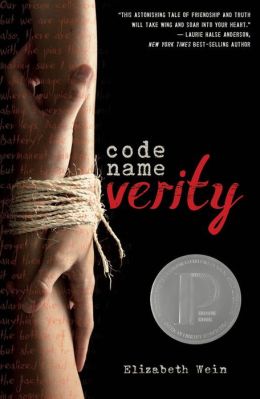 Elizabeth Wein is the author of this "companion novel" to Rose Under Fire, but I urge reading this one first to enhance understanding. These two books were both driven by the author's fascination with the Air Transport Authority--British women pilots in WWII. The story is divided into two parts, the first told by captured British spy, Julia Beaufort-Stuart, who is being held and tortured in the Gestapo headquarters of a French town. Per her account, which is conveyed via the notes she is supplying to the Germans in exchange for her life--temporarily--she is a traitor of the worst sort, supplying radio codes, names of airfields and types of aircraft. It is a somewhat rambling account that documents the development of her friendship with ATA pilot, Maddie Brodatt. Maddie, we learn from Julia, has been mechanically inclined all her life, able to take apart and repair all kinds of engines, and she is also passionate about flying. Julia is shown photos of the plane in which Maddie flew her to France that crash landed after Julia parachuted. The photos supposedly document the complete incineration of the plane, with Maddie onboard. The accounts of torture, for both Julia and the resistance fighters also being held in the same prison, are horrific, if somewhat obliquely described.
Elizabeth Wein is the author of this "companion novel" to Rose Under Fire, but I urge reading this one first to enhance understanding. These two books were both driven by the author's fascination with the Air Transport Authority--British women pilots in WWII. The story is divided into two parts, the first told by captured British spy, Julia Beaufort-Stuart, who is being held and tortured in the Gestapo headquarters of a French town. Per her account, which is conveyed via the notes she is supplying to the Germans in exchange for her life--temporarily--she is a traitor of the worst sort, supplying radio codes, names of airfields and types of aircraft. It is a somewhat rambling account that documents the development of her friendship with ATA pilot, Maddie Brodatt. Maddie, we learn from Julia, has been mechanically inclined all her life, able to take apart and repair all kinds of engines, and she is also passionate about flying. Julia is shown photos of the plane in which Maddie flew her to France that crash landed after Julia parachuted. The photos supposedly document the complete incineration of the plane, with Maddie onboard. The accounts of torture, for both Julia and the resistance fighters also being held in the same prison, are horrific, if somewhat obliquely described.This award winning book by
The second part of the book is Maddie's tale, told through notes she kept while hiding with the Resistance fighters in France. We learn that, due to an emergency, she decides to fly Julia to France, even though technically she is not authorized to fly into a war zone. ATA pilots were only supposed to ferry planes within Britain. They come under fire, damaging the tail of the plane and forcing Maddie to crash land after dropping off Julia. The plane was supposed to return British pilots, being helped and hidden by the Resistance, back to England. Now she becomes one of those in hiding and puts her skills to use learning to make explosives. Indirectly, through her section leader, she learns that Julia has been captured and is very likely being held and tortured in the nearby town. One night, her group of saboteurs get information about a prisoner transport and determines to blow up a bridge and free the prisoners. Things go terribly wrong and Maddie kills Julia--at Julia's request--to avoid her being taken to the concentration camps for medical experiments. A woman who had been present at Julia's interrogations secretly brings Julia's notes to Maddie and she learns that, in spite of Julia's reputation within the prison as a collaborator, she has revealed not a single piece of useful information to the Germans.
There is a several page "Author's Debriefing," after the story itself, that describes some of the source material for the novel and it is well worth reading. Although ostensibly written for young adults, these are really remarkable stories, with compelling characters, clever plotting, and a sometimes painfully clear description of what happened to people in WWII. Highly recommended for adults and recommended with caution for YA's. This review in the NYT also gives a wonderful flavor for the book.
No comments:
Post a Comment